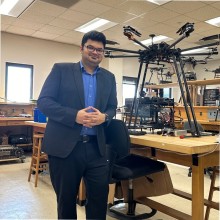Spectrum Coexistence between Active Wireless Technologies and Passive Remote Sensing Systems
As the demand for access to the radio frequency spectrum accelerates due to the growth of mobile networks, radar systems, and emerging wireless technologies, shared use of this spectrum has become inevitable. This has raised a critical challenge: how to ensure spectrum coexistence between active wireless systems, which transmit signals, and passive sensors like microwave radiometers, which are highly sensitive receivers designed to estimate the Earth’s natural thermal emissions. These radiometers play an essential role in Earth observation missions and weather forecasting, enabling the retrieval of key geophysical parameters such as soil moisture, ocean salinity, and atmospheric water vapor. However, the increasing spectral overlap between these systems, especially as radiometers operate more frequently in unprotected or adjacent bands, makes them vulnerable to radio frequency interference (RFI). This interference can bias radiometric measurements and threaten the accuracy of scientific products derived from them. Ensuring spectrum coexistence therefore requires not just regulatory protections, but also robust technical solutions that allow passive sensors to operate reliably in contested environments. This talk presents a comprehensive, deep learning-based framework for enabling spectrum coexistence through advanced RFI detection, fine-resolution interference mitigation, and data- driven radiometric calibration. The approach is validated using NASA SMAP satellite data and through controlled experiments involving a custom-built L-band radiometer exposed to realistic wireless interference scenarios. By integrating these components into an end-to-end processing pipeline, we demonstrate how contaminated observations can be transformed into accurate, calibrated radiometric brightness temperature measurements. This work highlights not only the technical feasibility of coexistence, but also its necessity for the future of Earth observation and weather forecasting. By equipping passive systems with intelligent, interference-aware processing, we pave the way for meaningful spectrum sharing that supports both technological innovation and the continuity of critical Earth science missions.

Ahmed Manavi Alam
NC State Student, North Carolina State University on November 21, 2025 at 12:00 AM in EB2 1231
Join Zoom Webinar
Ahmed Manavi Alam is a Ph.D. candidate in Electrical Engineering at NC State University and a Research Assistant in the Information Processing and Sensing Lab. He holds an M.S. in Electrical and Computer Engineering from Mississippi State University and a B.S. in Electrical and Electronic Engineering from Bangladesh University of Engineering and Technology. His research lies at the intersection of wireless communications, signal processing, and machine learning, with applications in radar and remote sensing. Ahmed has contributed to several federally funded projects, including NASA’s SMAP and NSF’s SWIFT-SAT, focusing on spectrum coexistence, radio frequency interference (RFI) mitigation, and radiometer calibration using deep learning. He previously served as a Lecturer at Daffodil International University in Dhaka, Bangladesh. His industry experience includes a research co-op in audio machine learning at Bose Corporation based on Framingham, Massachusetts. Ahmed is an active member of the IEEE and serves as a reviewer for leading journals, including IEEE TGRS, JSTARS, and TRS.
This lecture series features exciting and dynamic visiting and virtual speakers from across the range of ECE disciplines. Take some time every Friday morning to be inspired by these great scientists and engineers before heading into the weekend!
